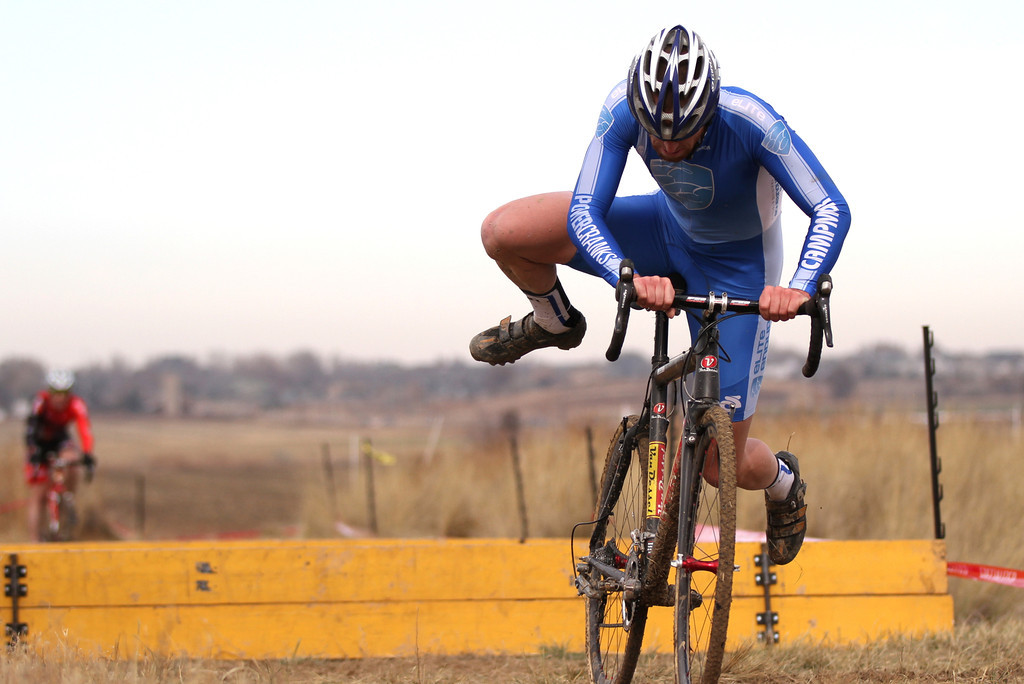During a cyclo-cross event, if you can dismount and mount more efficiently than your competitors, not only will you save time and energy, but you’ll also build priceless confidence…
If a rider is confident, he/she will approach the barrier faster and hopefully clear it faster and save time…
You see lots of riders do this incorrectly. They get off their bikes too late. They slow, try to bunnyhop the barrier. They get off their bikes too early. They try to clip out both feet too quickly. They don’t grab the bike in the proper place, banging their bodies and the barrier.
In my opinion, the dismount and remount are equally difficult. I like to always keep things consistent and simple. Remember “tracking” when you were in Driver’s Education? Mr. Rogers used to always say, “When you’re driving on the highway, don’t look right in front of you. You want to look down the road.” You are tracking where you want to go. Well, when you’re approaching that barrier, you want to do the same thing. Keep that head up! You will go much faster and smoother…
You want to go full speed up to that barrier, then clip out with your right (or left) leg. With your hands on the hoods, swing your leg over. Now you’re gliding up to the barrier, standing on that one pedal. No stutter steps. Time your dismount so it’s a seamless transition. You want to time it so when you pop out of the pedal, you only take two steps and BOOM you’re over that barrier. If you’re taking more than five steps, you’re losing time and efficiency. When you’re running, hold the bike by the top tube with one hand. Your other hand is on the brake hood, guiding the front end.
And you’re over the barrier, lickety split.
Now, the remount can be tricky. A lot of riders end up PLOPPING back onto the saddle. You want to be as smooth and light as possible. The harsher you remount, the more you’re going to slow yourself down in the end. Remember: cyclo-cross races are not five minutes long.
Make sure the bike is stable. You want to keep your hands on the hoods — it’s just a faster transition than keeping your hands on the tops. The trick is to keep your momentum as you fly over the barrier. You want to hop back on the bike, feathering the inside of your thigh on the saddle first to make sure you get situated properly on the bike. As Simon Burney writes in his classic book “Cyclo Cross,” you want to “glide” back onto the saddle… Then clip in with your dominant leg and try to get up to speed, clipping in second leg (PowerCrankers have huge advantage here).
Over time, you will be able to get back onto that saddle with feathery light touch, get into
that pedal, and rip away as if it were breathing — it will become intrinsic.
Like all great athletes performing at the top level of their sport, great cyclo-cross racers look very graceful during this transition. Over time, this potentially tricky part of the course can become something that’s easy and automatic for you.
On some courses, the climbs are too steep, or too slick because of the conditions. If you’re going to dismount, make sure you shift into an easy enough gear to get going again, THEN dismount. Don’t dismount in the gear you’re naturally riding in — you may have catastrophic problems getting going again!!!
Also, a common mistake is a rider gets on the climb, then loses momentum, ends up crawling, THEN dismounts. There is nothing wrong with foreseeing this: get off the bike before the climb! Get off BEFORE you lose momentum, not as you’re losing it… You want to pick up the bike from the top tube and swing it over your shoulder (if the run is going to take more than 15s). This will allow you to carry the bike comfortably but also allow you to run balanced and upright — FASTER!!!
For the cyclo-cross maniacs with whom I work, we started the running portion very easy. WV Cross is an early event, and some of the guys found the run-up difficult… The key when preparing for the run is to start easy, doing some easy jogs in place of Recovery Rides, and near the middle of the Builds and Peak weeks, the short sprints (different for each rider) will be a normal part of training that requires no added recovery…
Some riders opt not to train the run. They’re in good shape, they’ll just wing it… But some races do have longer running sections, and if the conditions are slippery or difficult or arduous, the athlete who is conditioned to run with his/her bike will have a huge advantage as the race progresses…
I hope this helps. Thanks for reading…

